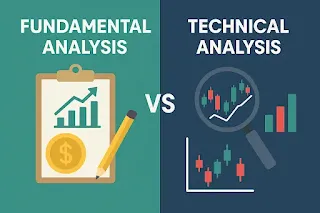Fundamental vs Technical Analysis: A Clear Explanation
Introduction: An overview 📝

1. What is fundamental analysis: How does it work?
Fundamental analysis is a
method used to determine whether a company's stock (or any investment) is a good buy or not by using financial information, business performance, industry trends and economic factors to understand the true value of the company.
In fundamental analysis, we look
at both qualitative as well as quantitative factors, some of them are:
🗣️Qualitative factors (Non-numerical things)
✔ Company’s business model
✔ Company’s management
✔ Company’s reputation and market position
📊Quantitative factors (Numbers & Data)
✔ Revenue (sales)
✔ Profit (net income)
✔ Financial ratios (like P/E ratio, EPS, etc.)
✅ The main aim
of fundamental analysis is to find out the intrinsic (or true)
value of a stock (or any investment).
If intrinsic value >
market price → The stock is undervalued
If intrinsic value <
market price → The stock is overvalued
📢 But this doesn't mean you should simply buy undervalued assets and avoid overvalued ones; there can be many reasons behind an asset being under or overvalued.
2. Fundamental analysis tools: A practical guide
There are many tools that we use in fundamental analysis. Some tools show a company’s financial condition, while others explain the possible impact on its stock price.
Let’s take a look at some of these tools:
(a)Economic indicators: Economic indicators help us understand the overall health of the economy; some of them are: GDP (gross domestic product), unemployment rate, interest rate. Sometimes, a company may be doing okay, but the economy affects how well it can perform.
(b)Financial statements: F
(c)Ratios: These are simple math formulas that give us a quick idea of a company’s financial health; some of them are: PE ratio (price-to-earnings), ROE (return on equity), Debt-to-Equity, EPS (earnings per share), ROA (return on assets), NPM (net profit margin), CR (current ratio).
(d)Industry conditions:
Here’s how:
✅ Good industry = More opportunities
📈 Higher costs = lower profit
⚖️ Stricter rules = more challenges (or sometimes benefits)
⚠️ Too much competition = tough times
(e)News and events: News and events can be economic, industry or company- specific, such as Earnings Reports, Product Launches, Management Changes, Elections, and Scandals; the effects of news and events can be both positive and negative.
💡Smart Investors Know This(AD)3. What is technical analysis: How does it work?
Technical analysis is a
method to decide when to buy or sell a stock (or any investment) by analyzing its past data on charts by using patterns, indicators, charts, and
other tools.
In technical analysis, we try to predict future price movements so that we can decide whether to take a position or not. If we do take a position, we also determine whether it should be a short position or a long one.
You know, there's a saying in
technical analysis: "What happened before will happen
again." That's why many people buy at the demand zone and
sell at the supply zone.
But it's not always true that what happened before will happen again; that's exactly why things like breakouts and breakdowns exist!
4. Technical analysis tools: A practical guide
There are many tools that we use in technical analysis; Some of them tell us about the trend while others tell us about the momentum, strength, volatility, and trading volume. Some people use a single tool, while others use multiple tools. It totally depends on your trading style and strategy.
Let’s take a look at some of these tools:
(a)Charts: A chart is a visual representation of how the price of an asset has changed over time, in which x- axis represents time and y-axis represents price; there are different types of charts, and each chart represents the data in a different way.
Some of them are: Line Chart, Bar Chart (OHLC), Candlestick Chart, Heikin-Ashi Chart.
(b)Chart patterns: These are shapes or formations created by a group of candlesticks, and they serve as signals for either a continuation or a reversal of the trend.
Some of them are: Head and shoulders, Double top/bottom, Cup and handle, Bullish triangle, Bearish triangle, Rising/Falling wedge, Ascending/Descending triangle.
Note: Chart patterns usually require at least 10–15 candles to form a meaningful shape/formation.
(c)Candlestick patterns: They are shapes or formations formed by a single or multiple candlesticks; which signal a possible continuation, reversal of the trend, or indecision in the market.
Some of them are: Hammer, Inverted hammer, Evening star, Morning star, Tweezer top, Tweezer bottom, Dragonfly doji, Standard doji, Spinning Top, Hanging man, Shooting star.
Note: Most common candlestick patterns involve 1 to 3 candles, and a few go up to 5 candles.
(d)Indicators: Indicators are special tools or formulas that traders use on a chart to help them: Understand price movement, Spot trends and Know when to buy or sell; they are based on price, volume, or time.
Some of them are: Moving Average, MACD, Volume, On-Balance Volume (OBV), Bollinger Bands, ATR (Average True Range), RSI (Relative Strength Index), Stochastic Oscillator.
(e)Demand zone: This is a price area/zone where a lot of buyers are waiting to buy, also known as support zone/area.
(f)Supply zone: This is a price area/zone where a lot of sellers are waiting to sell, also known as resistance zone/area.
💡Smart Traders Know This(AD)5. Difference between fundamental and technical analysis?
This question might also come to your mind — 'How does fundamental analysis differ from technical analysis?' 🤔 Let's take a look.
| Point of difference | Fundamental analysis | Technical analysis |
|---|---|---|
| Meaning | It is a method used to determine whether a company's stock (or any investment) is a good buy or not by using different tools | It is a method to decide when to buy or sell a stock (or any investment) by looking at its past data on charts by using different tools |
| Tools | Financial statements, Ratios, etc. | Charts, Candlestick patterns, etc. |
| Used By | Mostly long-term investors | Mostly short-term traders |
| Used For | Long-term investing, value investing | Day trading, swing trading, short-term decisions |
| Looks At | Revenue, profit, management, industry, economy, etc. | Past price, volume, patterns |
| Belief | "Price can be wrong; real value comes from business performance" | "Everything is already reflected in the price" |
6. Which type of analysis is right for you?
This question might also come to your mind — 'Which is more important, fundamental or technical analysis? '📊💡 Let's take a look.
🎓Based on career goals:
📚Fundamental analysis: Equity research analyst, Portfolio manager, Financial Advisor, etc.
📊 Technical analysis: Technical analyst, Trader, Charting expert or coach, etc.
💼Based on style:
📚Fundamental analysis: Investing
📊Technical analysis: Trading
🧠Smart strategy:
✅Ask yourself: What is my career goal? Do I want to focus fully on investing or trading? What am I genuinely interested in? You'll find your answer.
✅Learn both: You can learn both if you have enough time. Many people use both — for example, they use fundamental analysis to find valuable companies and technical analysis to find the right time to enter
😊Which Strategy Wins(AD)📝Conclusion
💬 Feedback: Google forms
👁🗨 Must read: Your Guide to Unlisted Stocks
🎯 Quiz: Test What You’ve Learned
📌Disclaimer: The information provided in this blog is for educational purposes only and should not be considered as financial or investment advice. Please do your own research or consult a financial advisor before making any investment decisions.
Advertisement
Subscribe for Updates
Blog Updates 🔔
Get notified when we publish new blogs
Thank you!
You have successfully joined our subscriber list.
